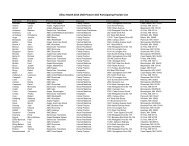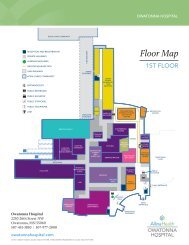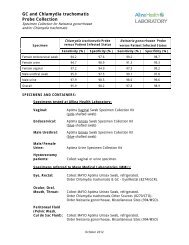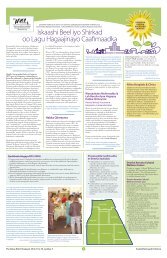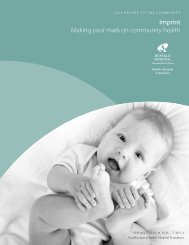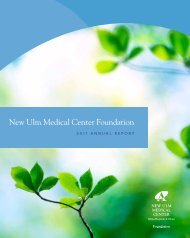Human (Granulocytic) Anaplasmosis (HGA ... - Allina Health
Human (Granulocytic) Anaplasmosis (HGA ... - Allina Health
Human (Granulocytic) Anaplasmosis (HGA ... - Allina Health
You also want an ePaper? Increase the reach of your titles
YUMPU automatically turns print PDFs into web optimized ePapers that Google loves.
July 2012<br />
<strong>Human</strong> (<strong>Granulocytic</strong>) <strong>Anaplasmosis</strong> (<strong>HGA</strong>) & Babesiosis<br />
Revised 08/07/2012<br />
Linda Riley, MD<br />
The milder than normal past winter suggests that there may be increased<br />
incidence of tick-borne illnesses in the upper Midwest, including Minnesota,<br />
during 2012. Lyme disease was discussed in a prior Best Practices in Laboratory<br />
Testing article in July 2010. In the current issue, <strong>HGA</strong> and Babesiosis are<br />
presented. Further data about these diseases or related diseases may be<br />
obtained from Minnesota Department of <strong>Health</strong> (MDH) and Center for Disease<br />
Control (CDC) web sites (see references below).<br />
<strong>Health</strong> care providers are required to report to MDH (MDH Phone : 651-201-<br />
5414) all confirmed or suspected cases of Lyme disease, <strong>Anaplasmosis</strong>,<br />
Babesiosis, Rocky Mountain Spotted Fever, Ehrlichiosis and Powassan (POW)<br />
Virus.<br />
<strong>Human</strong> <strong>Granulocytic</strong> <strong>Anaplasmosis</strong> (<strong>HGA</strong>)<br />
The Family Anaplasmataceae includes the genera Anaplasma and Ehrlichia,<br />
which are tick-borne 0.5 micron obligate intracellular gram negative rickettsial<br />
coccobacillary bacteria that reside in cytoplasmic vacuoles within white blood<br />
cells.<br />
The terms “<strong>Anaplasmosis</strong>” and “Ehlichiosis” are often used interchangeably,<br />
including in the <strong>Allina</strong> <strong>Health</strong> laboratory system, which, although technically not<br />
quite correct, serves well for our purposes. <strong>HGA</strong> was formerly known as <strong>Human</strong><br />
<strong>Granulocytic</strong> Ehrlichiosis but was renamed <strong>HGA</strong> in 2003. It is the second most<br />
common tick-borne disease in Minnesota after Lyme disease. It is transmitted to<br />
humans by ticks of Ixodes genus including Ixodes scapularis (also known as<br />
deer tick or blacklegged tick, previously called Ixodes dammini), the same tick<br />
that transmits Lyme disease and babesiosis. Co-infections with agents of Lyme<br />
disease and/or babesiosis can occur from the same tick bite.
In 2010, there were 720 reported confirmed or probable cases of <strong>HGA</strong> in Minnesota (16.9<br />
cases per 100,000 population), more than twice the number reported in 2009. 59% were in<br />
males, the median age was 57 years, and the majority of cases were reported in May-July,<br />
with a peak in June. 27% of patients were hospitalized (1-42 days) and there was one<br />
reported death. 5% of <strong>HGA</strong> cases also had Lyme disease, and 1% also had confirmed or<br />
probable babesiosis. The frequency of co-infection may be underestimated.<br />
A disease related to <strong>HGA</strong>, called <strong>Human</strong> Monocytic Ehrlichiosis, is caused by Ehrlichia<br />
chaffeensis. It is uncommon in Minnesota. It is found throughout much of the southeastern<br />
and southcentral United States and is carried mainly by the Lone Star tick. However, a few<br />
cases of Ehrlichia muris-like agent-related disease, carried by I. scapularis, have been reported<br />
in Minnesota and Wisconsin since 2009. Ehrlichia ewingii, the agent of canine granulocytic<br />
ehrlichiosis, may occasionally cause an ehrlichia-like illness in humans.<br />
Anaplasma phagocytophilum (formerly known as Ehrlichia phagocytophilum) is the agent of<br />
<strong>HGA</strong>. It has tropism for neutrophils (whereas E. chaffeensis has tropism for monocytes). The<br />
incubation period is typically 7-10 days before development of overt symptoms, although onset<br />
of illness may be 5-21 days after exposure. Disease transmission is usually from tick bite,<br />
although other reported routes include blood inhalation/percutaneous blood exposure<br />
following butchering of white-tailed deer, blood transfusion, and transplacental infection. Many<br />
infections go undiagnosed because of the mild nonspecific symptomatology associated with<br />
the majority of infections.<br />
Symptoms typically include chills, fever, headache, myalgias and arthralgias. Less common<br />
symptoms include nausea/anorexia and vomiting, weight loss, abdominal pain, cough,<br />
diarrhea, and mental status changes. Rare patients will develop encephalitis, acute respiratory<br />
distress syndrome, or shock-like illness with multiorgan involvement. Disease tends to be most<br />
severe in elderly or immunocompromised individuals. The fatality rate is usually less than 1%,<br />
although some sources state a 2-3% fatality rate, and may be associated with opportunistic<br />
superimposed fungal or viral infection.<br />
Laboratory Findings:<br />
The majority of patients will have thrombocytopenia. Approximately 50% will have leukopenia.<br />
Liver function tests (LFTs) may be elevated due to hepatocellular injury.<br />
Pathology:<br />
Intravacuolar bacterial microcolonies reside in neutrophils and may be seen by microscopic<br />
evaluation when peripheral blood is smeared on a slide and stained by the Wright-Giemsa<br />
method. These microcolonies resemble a mulberry and are therefore called morules or<br />
morulae because the Latin word for mulberry is “morula.”<br />
2
Morules in neutrophils indicated by arrows<br />
Other pathologic findings include infiltrates of foamy macrophages in reticuloendothelial organs,<br />
multiorgan perivascular lymphohistiocytic infiltrates, and focal hepatocellular apoptosis<br />
(reflecting the hepatocellular injury manifesting as elevated liver function tests (LFTs)).<br />
Treatment:<br />
The first-line treatment for adults and children of all ages, as recommended by the CDC, is<br />
doxycycline. Treatment should be initiated immediately whenever <strong>HGA</strong> is suspected. For patients<br />
who are allergic to doxycycline or have other contraindications, alternative antibiotic<br />
treatment should be considered (see CDC for recommendations and doses). However,<br />
prophylactic antibiotic treatment following a tick bite in an individual who has not developed<br />
disease is not recommended, since there is no evidence that this is effective.<br />
3
Laboratory-based diagnostic methods:<br />
Test<br />
Turnaround<br />
Time<br />
Sensitivity<br />
Comments<br />
LAB 453/EHL<br />
Ehrlichia Smear<br />
Identification of<br />
morulae in<br />
neutrophils or<br />
monocytes.<br />
LAB 2780/EDP<br />
Ehrlichia/Anaplasma<br />
PCR<br />
Detects and differentiates<br />
DNA of<br />
Anaplasma phagocytophilum,<br />
Ehrlichia chaffeensis,<br />
Ehrlichia<br />
ewingii, and<br />
Ehrlichia muris-like<br />
Same day<br />
Performed at<br />
<strong>Allina</strong> Medical<br />
Laboratories<br />
1-3 days<br />
Test Referred<br />
to Mayo Medical<br />
Labs<br />
20-80% sensitivity<br />
during the first<br />
week of infection<br />
60-70% sensitivity<br />
during first week of<br />
illness.<br />
A positive test<br />
result is helpful but<br />
a negative test result<br />
does not rule<br />
out disease.<br />
This is an insensitive<br />
method (although dazzling<br />
when it works).<br />
A negative examination<br />
should NOT dissuade you<br />
from initiating treatment if<br />
the clinical presentation<br />
and routine laboratory<br />
findings support the diagnosis<br />
of <strong>HGA</strong>.<br />
Test of choice for Ehrlichia<br />
muris-like organisms.<br />
Treatment should not be<br />
withheld due to a negative<br />
result. This test should not<br />
be used to test<br />
asymptomatic individuals.<br />
LAB 2785/EHR<br />
Ehrlichia Antibody<br />
Panel<br />
Detects IgG and<br />
IgM antibodies to<br />
Ehrlichia and Anaplasma.<br />
1-3 days<br />
Test Referred<br />
to Mayo Medical<br />
Labs<br />
94-100% sensitivity<br />
after 14 days.<br />
Antibodies may not<br />
be detectable during<br />
the first week<br />
of illness (when<br />
patients typically<br />
present for treatment).<br />
A positive titer indicates<br />
current or past infection.<br />
Paired sera should be<br />
collected 2-3 weeks apart.<br />
A four fold rise in titer<br />
confirms acute infection.<br />
4
BABESIOSIS<br />
Babesiosis (originally called “Nantucket fever” due to its initially recognized occurrence in the<br />
late 1960s on Nantucket Island) is a malaria-like illness caused by an apicomplexan protozoan.<br />
These organisms are found worldwide. Although there are many species, only a few are identified<br />
as causing human disease, including: B. microti, B. divergens, B. duncani (WA1 species),<br />
and a strain designated MO-1. Like malaria, Babesia species infect erythrocytes, but unlike<br />
malaria, babesiosis is transmitted by ticks, and the organism is found in a variety of animal<br />
species that serve as reservoirs. Our previously mentioned “friend” Ixodes scapularis (deer<br />
tick, blacklegged tick) is the usual tick vector.<br />
<strong>Human</strong> infections in the United States of America occur mainly in the upper Midwest and<br />
northeastern states due to infection by the rodent parasite Babesia microti (which infects the<br />
white-footed mouse and other small mammals and which is the main species that infects people<br />
in the United States). Tick larvae hatch in early summer from eggs laid in the spring by<br />
adult female ticks, and become infected when they take a blood meal from infected whitefooted<br />
mice. They molt into infected nymphs the following spring, and when they feed on<br />
mice or humans in late spring or early summer, these hosts then also become infected. The<br />
parasite is usually spread to humans by the young nymph stage of the tick (at which time the<br />
tick is about the size of a poppy seed). In the fall, the nymphs molt into adults that feed on<br />
white-tailed deer (that, according to some sources, do not become infected but nevertheless<br />
support/amplify the tick population by providing the blood meals); if these infected adult ticks<br />
feed instead on humans, they can infect humans at this time, as well. Thus, the main mode of<br />
transmission to humans is through the bite of an infected tick (usually nymph, sometimes<br />
adult), when humans engage in outdoor activities where Babesiosis is found.<br />
In human infection, the sporozoites which are introduced into the bloodstream by the biting<br />
tick attach to and enter the red blood cells (erythrocytes), where they mature into trophozoites<br />
that eventually bud to form four merozoites (these stages are visible via light microscopy,<br />
the four-merozoite stage sometimes characterized by the so-called “Maltese cross” formation<br />
in infected red blood cells).<br />
Babesia microti infection, Giemsa-stained thin smear<br />
5
Infection with Babesia<br />
The merozoites escape by causing rupture of the host erythrocyte, and are then free to invade<br />
other red cells. Multiplication of the parasites and rupture (hemolysis) of the red cells are<br />
responsible for the clinical manifestations of the disease. For practical purposes, humans are<br />
dead-end hosts; there is thought to be little, if any, subsequent transmission from infected<br />
humans to feeding ticks (although human to human transmission has been reported in the<br />
setting of transfusion of cellular blood products (see below), and possibly during pregnancy/<br />
delivery).<br />
Other infecting species (MO-1, B. duncani) have been reported in the western United States,<br />
thought to be transmitted by the western black-legged tick Ixodes pacificus. In Europe,<br />
infection of humans by B. divergens, transmitted by the sheep tick Ixodes ricinus, has been<br />
reported.<br />
In Minnesota in 2010, a record number of confirmed or probable cases (56, or 1.1 per<br />
100,000 population) were reported, compared to 31 cases the year before. 59% of reported<br />
patients were male, with median age 61 years (range 5-84 years). Onset of illness was elevated<br />
from June through August with a peak in July comprising 40% of cases. 46% of patients<br />
were hospitalized (range: 2 days – more than one month). One patient died. 14% of patients<br />
also had confirmed Lyme disease, and a different 14% had confirmed or probable <strong>HGA</strong>.<br />
Symptom onset after infection is usually 1-4 weeks (usually 1-9 weeks after infection resulting<br />
from transfusion).<br />
The spectrum of disease ranges from latent/subclinical to fulminant with hemolysis, multiorgan<br />
failure and death. The most severely affected tend to be those individuals who are asplenic,<br />
elderly or immunocompromised (i.e., HIV positive, underlying malignancy, corticosteroid<br />
treatment).<br />
6
Infected individuals may be asymptomatic. Symptoms/signs of the disease may include hemolysis,<br />
high fever, chills, muscle aches/arthralgias, headache, fatigue, loss of appetite,<br />
nausea and vomiting. More extreme expressions of disease include hypotension, hepatic<br />
dysfunction, renal failure, disseminated intravascular coagulation, multiorgan failure and<br />
death.<br />
Supportive laboratory findings may include hemolysis, thrombocytopenia, and elevated LFTs.<br />
Treatment:<br />
According to the CDC, most patients who are asymptompatic do not require treatment. Early<br />
diagnosis and treatment of symptomatic patients may reduce the length of illness and severity<br />
of disease. CDC recommendations include assistance from infectious disease specialists<br />
and antimicrobial drugs: Atovaquone + azithromycin for mild to moderate cases or<br />
Clindamycin + quinine for severe cases, usually for 7-10 days, although repeat treatment or<br />
monitoring of parasitemia may be necessary for some patients (immunocompromised, for<br />
example). Please see CDC or MDH web sites for dosing recommendations.<br />
Additionally, those patients with severe illness may require or benefit from supportive care<br />
such as: vasopressors, antipyretics, blood transfusions, exchange transfusions, dialysis, and<br />
mechanical ventilation.<br />
Laboratory Diagnosis:<br />
Bear in mind that some patients may be simultaneously infected with more than one tickborne<br />
infection.<br />
7
MDH recommends at least two of the following three tests for diagnosis:<br />
Test<br />
LAB 6607/MAL<br />
Malaria/Parasite Stain<br />
Specially prepared<br />
smear identifies parasites<br />
within infected<br />
red blood cells.<br />
Turnaround<br />
Time<br />
Same day<br />
Performed at<br />
<strong>Allina</strong> Medical<br />
Laboratories<br />
Sensitivity<br />
Highly sensitive during<br />
acute illness.<br />
Cannot differentiate<br />
between Babesia species.<br />
Comments<br />
A negative examination<br />
does not rule out the<br />
diagnosis.<br />
LAB 8076<br />
Babesia microti PCR<br />
Detects Babesia DNA<br />
in whole blood.<br />
1-3 days<br />
Test Referred to<br />
Mayo Medical<br />
Laboratories<br />
Highly sensitive<br />
May be helpful in cases<br />
of low parasitemia and<br />
can differentiate between<br />
species.<br />
LAB 994/MSO<br />
Babesia microti Abs<br />
IgG, IgM<br />
1-3 days<br />
Test Referred to<br />
Focus Labs via-<br />
Mayo Medical<br />
Laboratories<br />
88-96% sensitivity for<br />
B. microti<br />
IgM antibody first appears<br />
2 weeks after<br />
the onset of illness.<br />
IgG titers often exceed<br />
1:1024 during the<br />
first weeks of illness,<br />
and then decline gradually<br />
over 6 months to<br />
titers of 1:16 to 1:256<br />
Does not detect Babesia<br />
WA1 species (B.<br />
duncani) found on the<br />
west coast.<br />
A positive Babesia IFA<br />
test for IgM is<br />
insufficient for diagnosis.<br />
If IgM is positive but<br />
the IgG result is negative,<br />
a follow-up blood<br />
specimen drawn at<br />
least one week after<br />
the first should be tested.<br />
If the IgG result remains<br />
negative in the<br />
second specimen, the<br />
IgM result was likely a<br />
false positive result.<br />
8
TRANSFUSION-TRANSMITTED DISEASE<br />
Cases of transfusion-transmitted <strong>HGA</strong> and babesiosis do occur. Anaplasma can survive for<br />
more than one week in refrigerated blood. Leukoreduction reduces but does not eliminate the<br />
risk of transmission for <strong>HGA</strong>. Babesia organisms may also survive in refrigerated blood, and<br />
the transfusion-transmitted rate of babesiosis, thought to be higher than that of transfusiontransmitted<br />
<strong>HGA</strong>, may be as high as 1 in 1800 red cell units. American Red Cross reports that<br />
50% of recipients receiving Babesia-infected cellular products will demonstrate seroconversion.<br />
There is sharing of blood products nationally, so the packed red cells your patient receives<br />
may theoretically have come from anywhere in the United States. Some of the reasons<br />
why it is so hard to eliminate the risk of an infected blood product include: It is difficult<br />
to identify those donors who are infected before they become symptomatic or if they have<br />
subclinical infection; some donors infected with Babesia may harbor the parasite for months<br />
without overt symptoms; deferring donors during peak tick activity as potentially infected just<br />
because they are from disease-endemic areas would severely limit blood supply with little potential<br />
gain; and PCR testing of donors for <strong>HGA</strong> is cost prohibitive and felt to be of low yield.<br />
Transfusion-transmitted <strong>HGA</strong> and/or Babesiosis should be considered in patients who develop<br />
fever and thrombocytopenia post-transfusion. The incubation period before manifestation of<br />
symptoms in <strong>HGA</strong> appears to be 7-10 days, similar to that of <strong>HGA</strong> disease transmitted by tick<br />
bites. Symptom onset for Babesiosis is 1-9 weeks following the instigating tick bite; symptom<br />
onset for Babesiosis due to an infected blood product is also thought to be 1-9 weeks, although<br />
it may be shorter than for tick bites, presumably because more organisms are being<br />
introduced. Please contact the associated Blood Bank and MDH immediately about any suspected<br />
cases so that investigation can be undertaken.<br />
As always, please be vigilantly mindful of risks versus benefits when prescribing blood products,<br />
and make sure that you obtain informed consent from your patients.<br />
Also, be aware that the American Red Cross (ARC) is currently undertaking a look-back study<br />
to evaluate by IFA and PCR representative blood donations from high, moderate and low endemic<br />
areas. 10,000 total blood donations from Minnesota/Wisconsin/upper Midwest<br />
(considered a moderately endemic area by ARC) are reportedly going to be evaluated this<br />
year. Donors whose products test positive will be notified, and recipient tracing will be undertaken.<br />
If your patient is a recipient of one of these positive blood products, expect notification<br />
through ARC or via the blood bank/pathologist.<br />
9
Your Pets<br />
A study from Austria showed no increased seroprevalence for Anaplasma phagocytophilum in<br />
cat or dog owners compared to non-pet owners, suggesting that pets are not a likely source<br />
of infection. In Europe and possibly in Washington state, transmission of Babesia divergens<br />
by Ixodes ricinus to humans has been reported.<br />
More About Ixodes scapularis (Deer Tick, Blacklegged Tick):<br />
Reservoir hosts for <strong>HGA</strong> in the United States of America are the white-footed mouse<br />
(transient bacteremia of 1-4 weeks), other small mammals, and the white-tailed deer<br />
(persistent subclinical infection vs merely supplying the food source). <strong>Human</strong>s are infected<br />
with tick-borne diseases when they come into contact with the tick vector in reservoir animal<br />
habitats. Peak tick activity is April through September.<br />
High risk counties in Minnesota include the eastern two-thirds of the state, in the<br />
approximate mid-portion, in a swath oriented from northwest to southeast extending to the<br />
St. Croix River region.<br />
The ticks are found in wooded and brushy areas but may reside in your own back yard,<br />
especially if you live adjacent to woods or have abundant brush or leaf litter in your yard.<br />
Ixodes scapularis life cycle<br />
Engorged Ixodes scapularis tick<br />
Adult ticks are approximately 1/8 inch long. Nymphs are slightly less than 1/16 inch long.<br />
Typically the tick must be attached for at least 12-24 hours in order to transmit the bacteria<br />
(although this may be shorter for <strong>HGA</strong>). Not all ticks carry the culprit organisms. Additional<br />
photographs of the deer tick are available on CDC and MDH web sites.<br />
For information on preventing tick-borne disease and how to remove ticks, visit the MDH web<br />
site<br />
10
REFERENCES<br />
K. Annen, D.O., et al. Two Cases of Transfusion-Transmitted Anaplasma phagocytophilum.<br />
Am J of Clin Path. 2012;137:562-565.<br />
Skerget M, et al. Cat or Dog Ownership and Seroprevalence of Ehrlichiosis, Q Fever, and<br />
Cat-Scratch Disease. Emerg Infect Dis. 2003;9:1337-1339.<br />
McKechnie, D.B., et al. Survival of Ehrlichia chaffeensis in Refrigerated ADSOL-Treated<br />
RBCs. Transfusion. 2000; 40:1041-1047.<br />
Minnesota Department of <strong>Health</strong> web site: www.health.state.mn.us/<br />
Mayo Medical Laboratories web site: MayoMedicalLaboratories.com<br />
Personal Communication, American Red Cross, www.redcrossmn.org<br />
Centers for Disease Control web site: www.cdc.gov/<br />
Henry’s Clinical Diagnosis and Management by Laboratory Methods, 21 st Edition, 2007,<br />
Publisher Saunders Elsevier, ISBN: 978-1-4160-0287-1<br />
<strong>HGA</strong>: G. Woods M.D., D Walker M.D., “Chlamydial, Rickettsial, and Mycoplasmal Infections”,<br />
pp. 1007-1008<br />
Babesiosis: T. Fritsche, M.D. and R. Selvarangan, B.V.Sc., “Medical Parasitology”, pp.<br />
1134-1135<br />
E. Vannier and P. Krause, “<strong>Human</strong> Babesiosis”, New England Journal of Medicine June 21,<br />
2012; 366;25, pp. 2397-2407<br />
For questions, comments, or suggestions about this newsletter or other laboratory issues,<br />
please contact Lauren Anthony, MD, Medical Director of <strong>Allina</strong> Medical Laboratories,<br />
(612) 863-0409 or Lauren.Anthony@allina.com<br />
11




